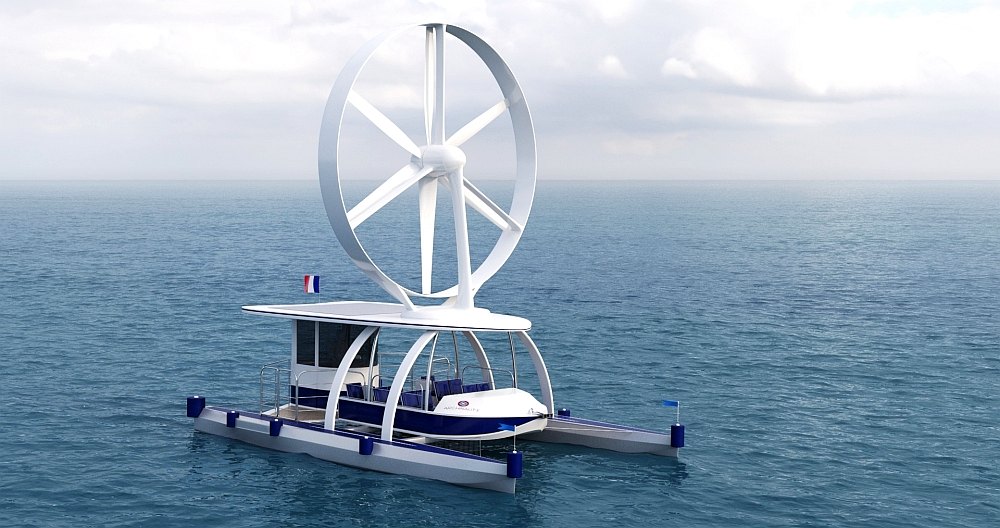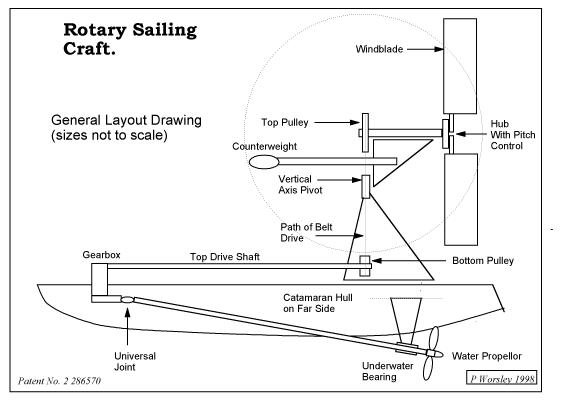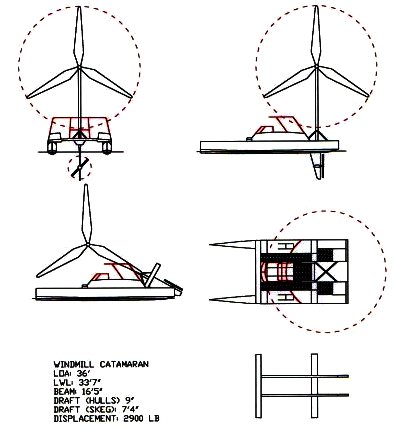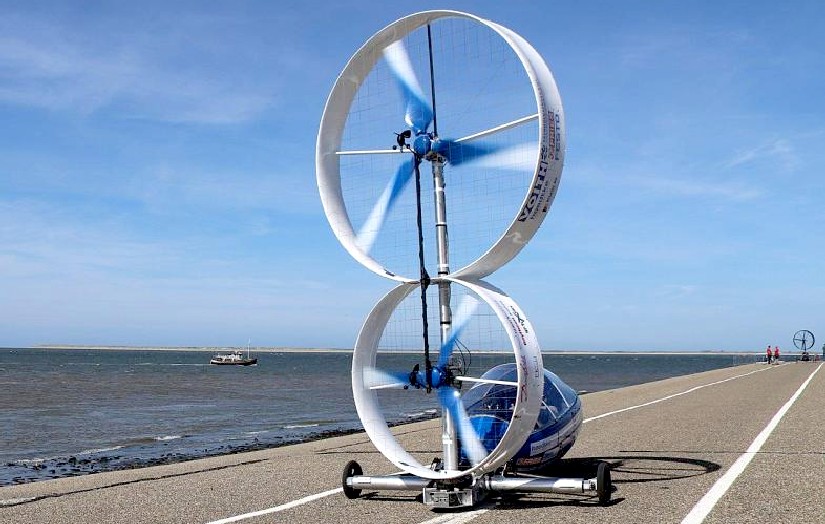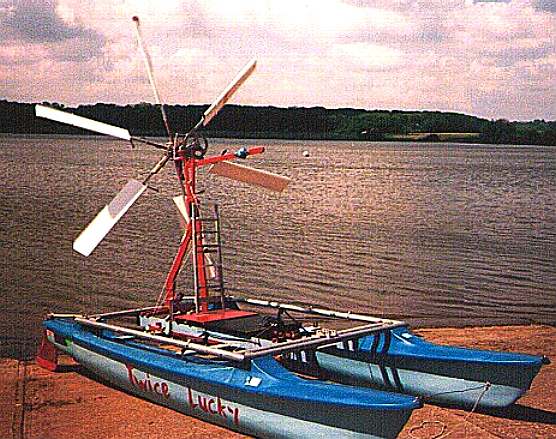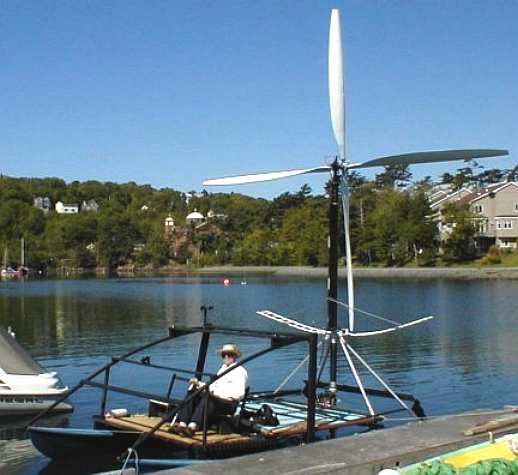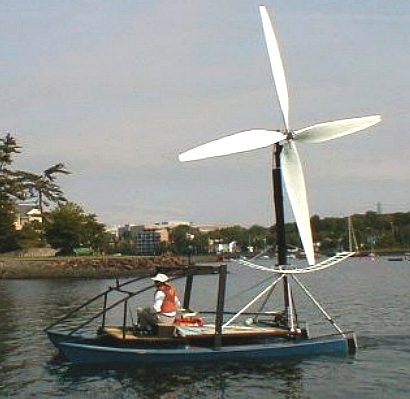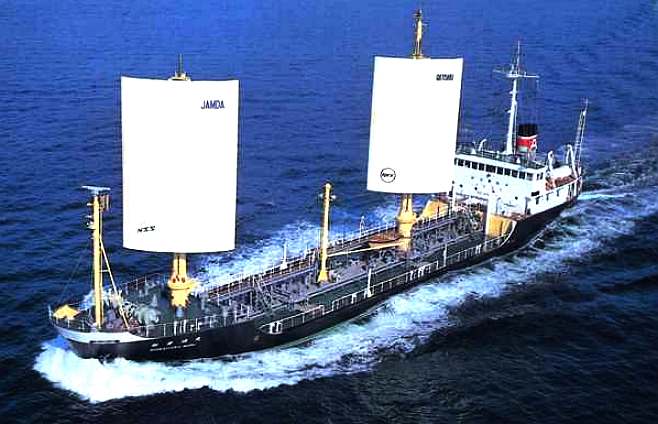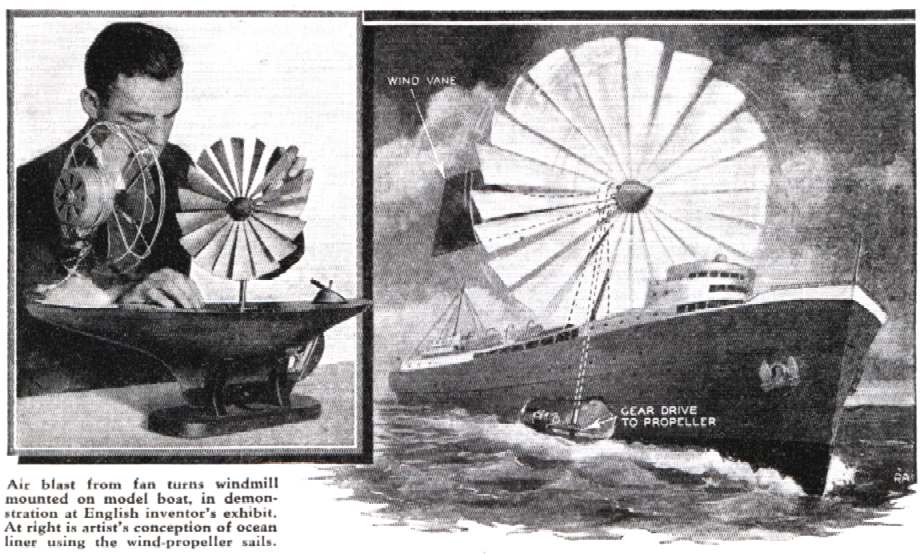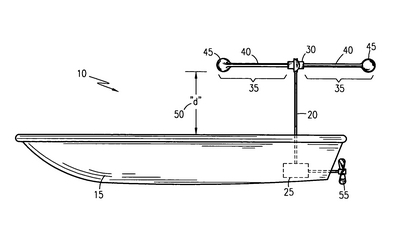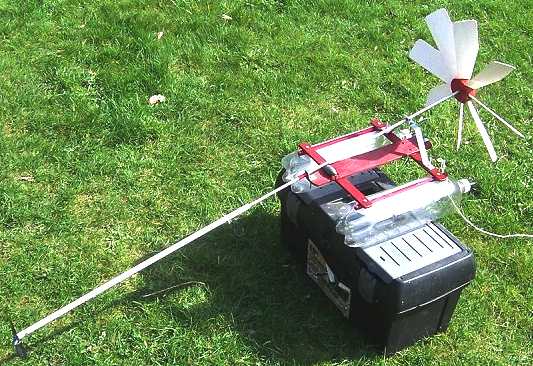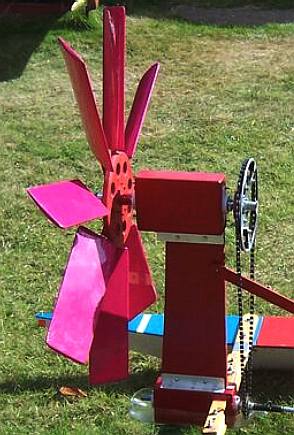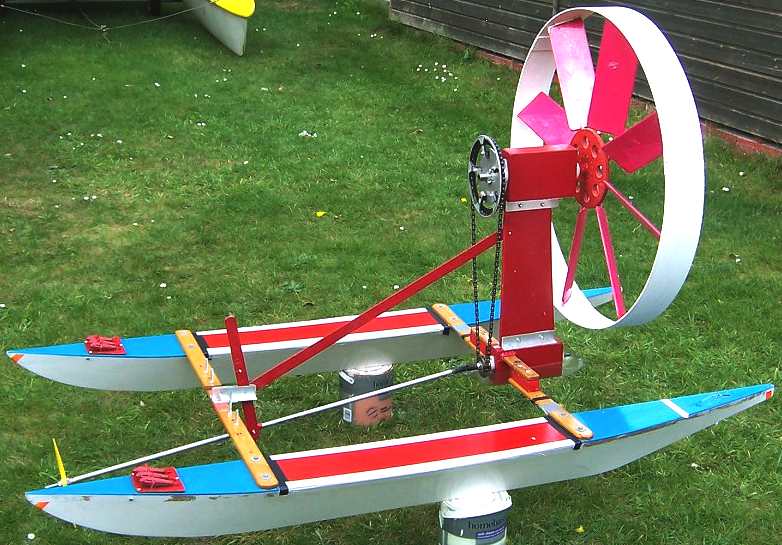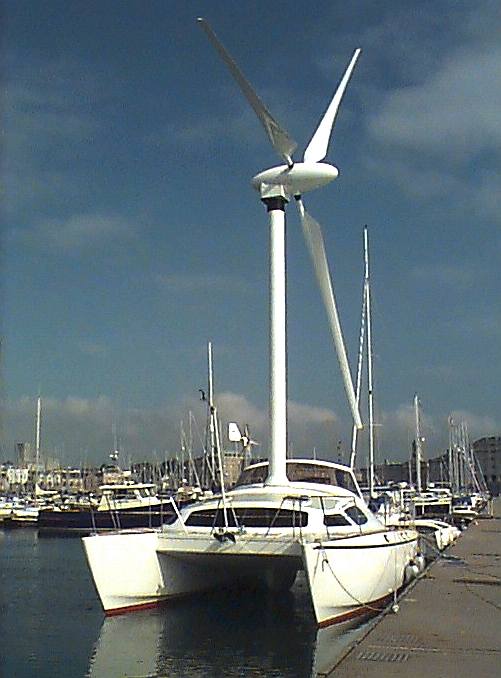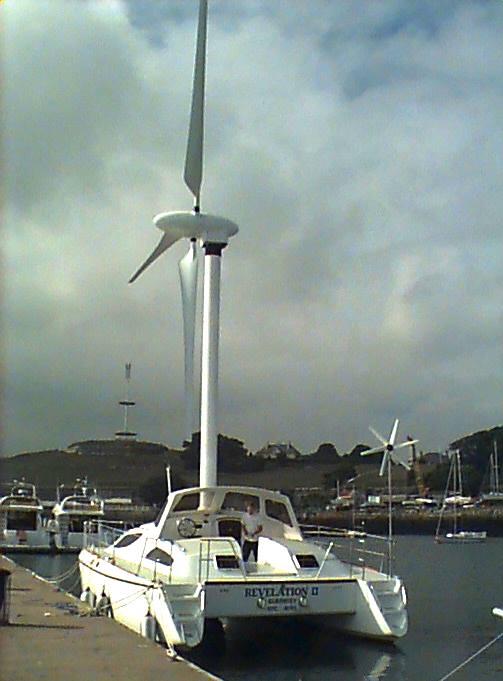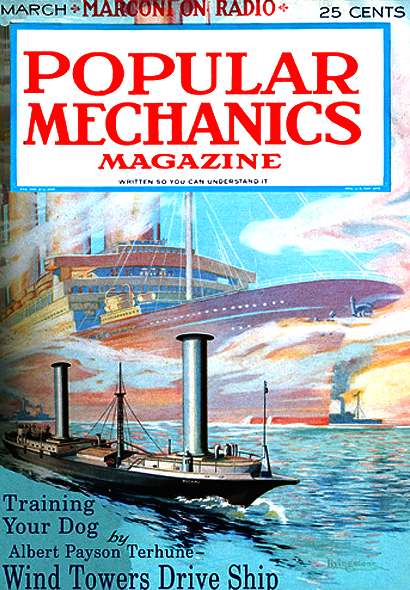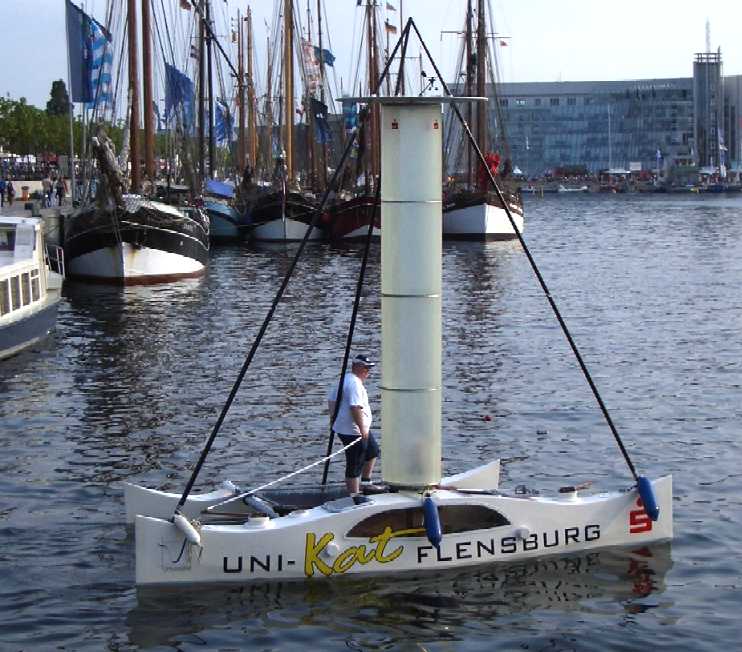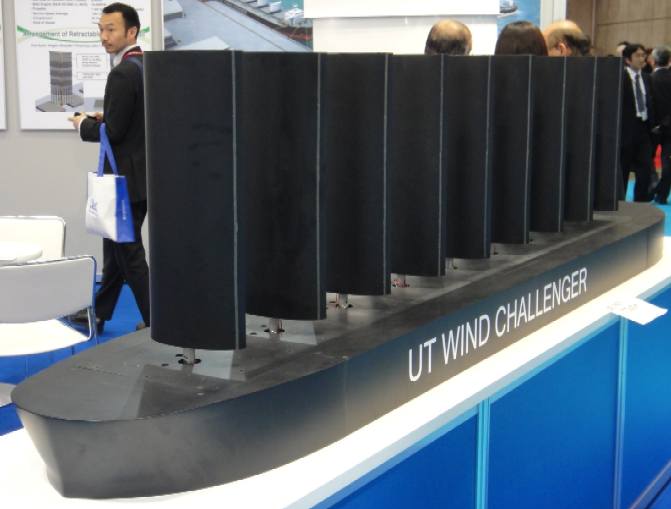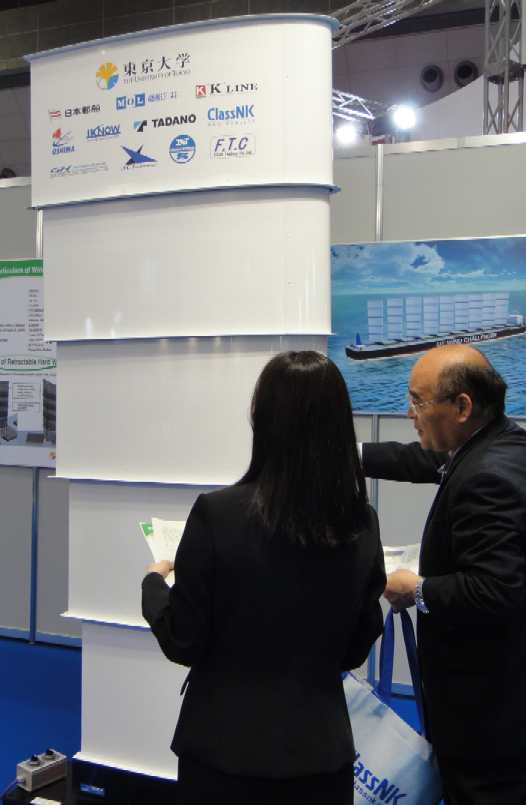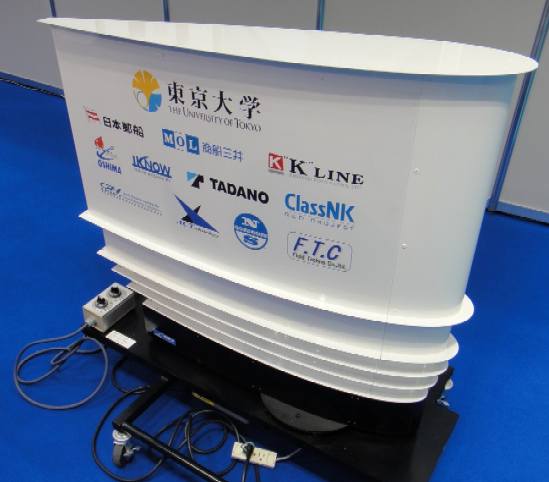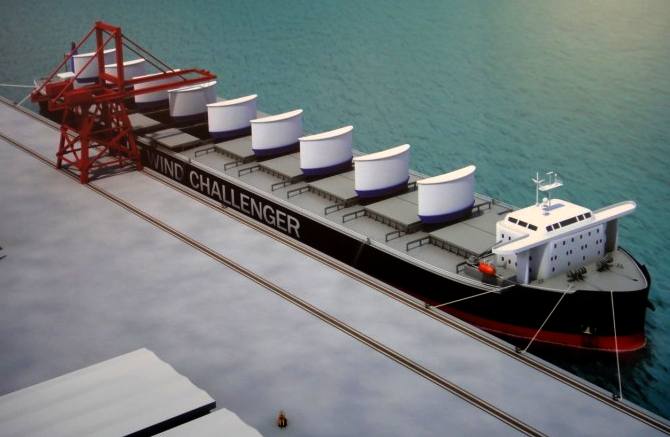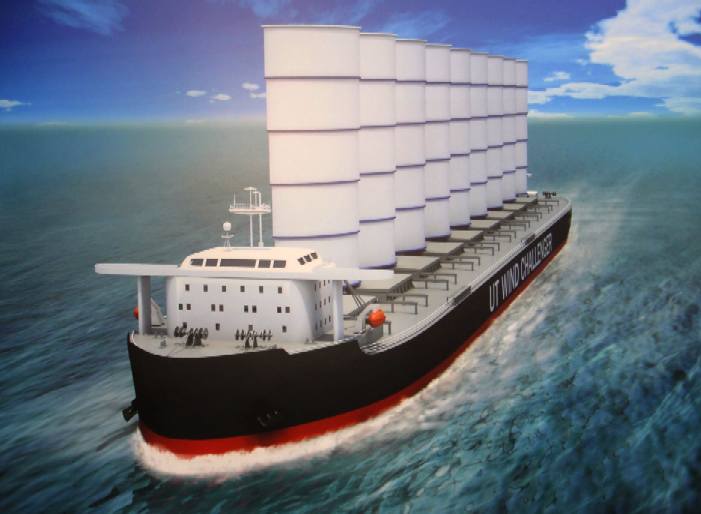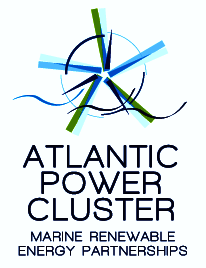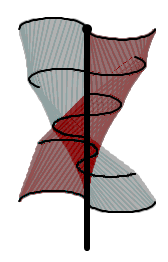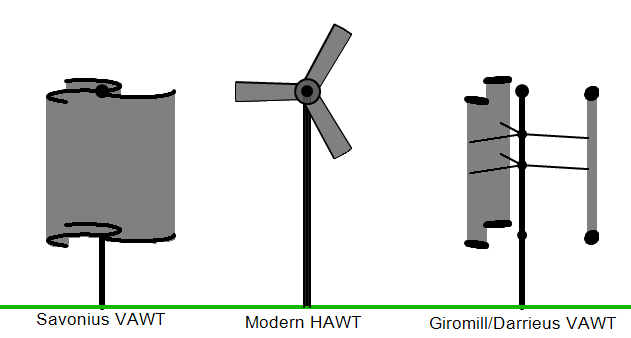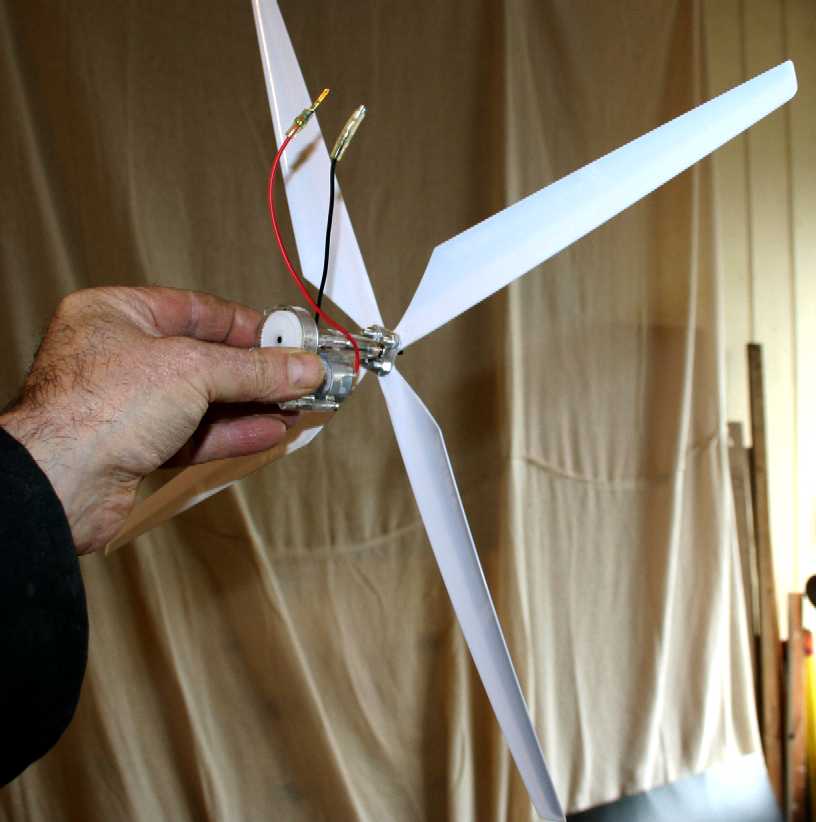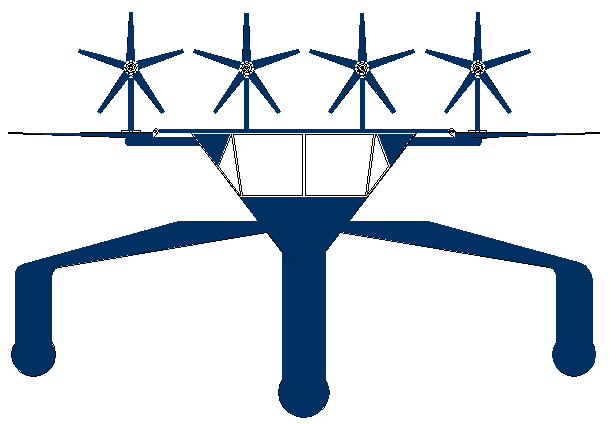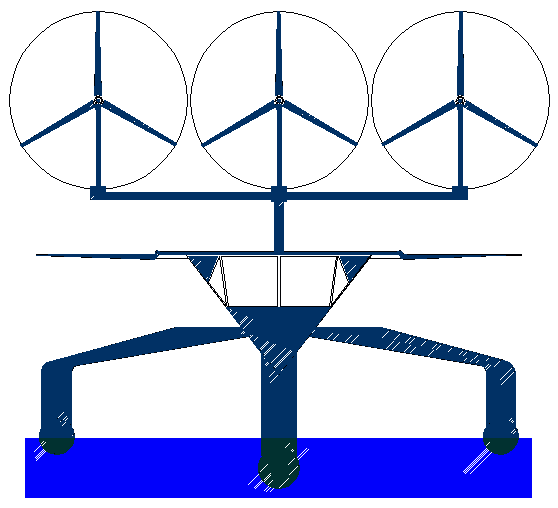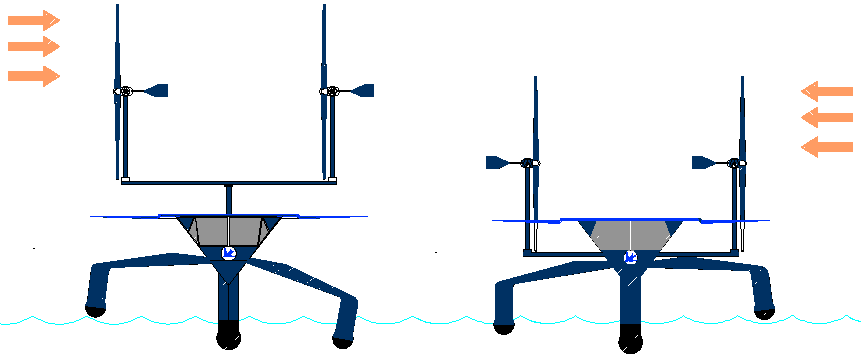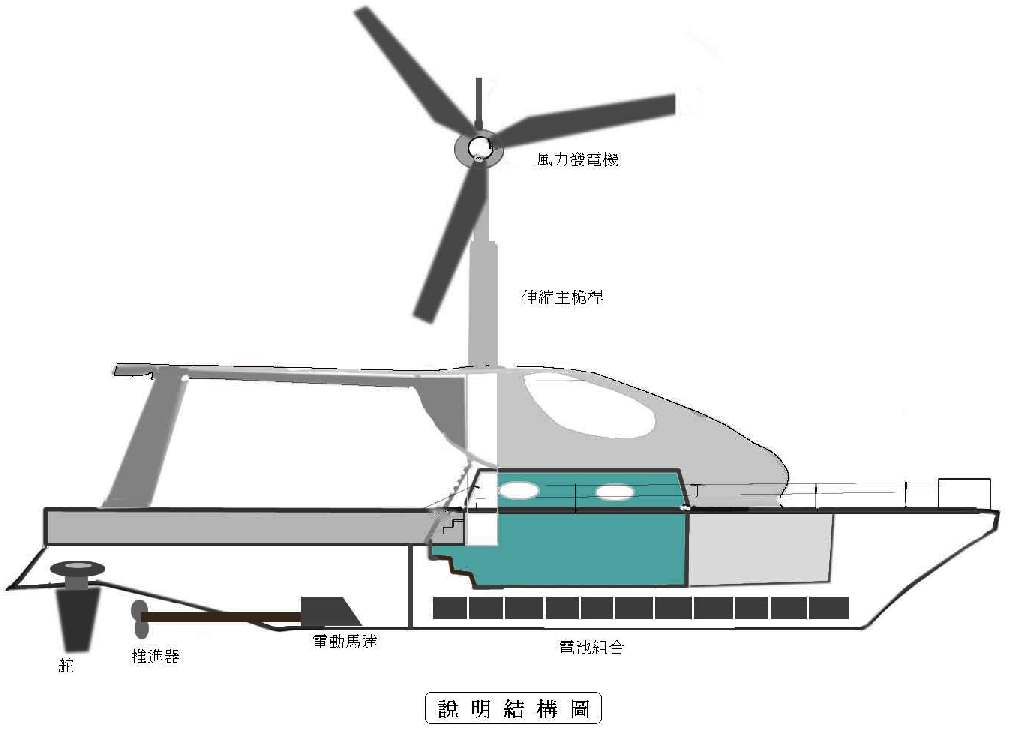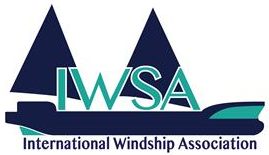|
WIND POWER - Renewable Energy Research
|
||||
|
Peter is an amateur yacht designer and an incredibly inventive and productive experimenter. All of his designs work to some degree - which, as he has refined his ideas, they are getting better. We love the rotary sail boats. Not quite so keen on the wing-sail designs, which were pioneered by Walker Wingsail Systems many years ago, but never really took off :) The idea seems to be a development of a fan ship proposal exhibited in 1935 at a patentees exhibition in London, although, we know that Peter developed his ideas independently from scratch. Nevertheless, there is a remarkable similarity, which supports the old adage that "great minds think alike." See Peter's nicely converted catamaran "Twice Lucky" below and compare that to Brad Blackford's Hobie catamaran further down.
AEOLUS DRAG RACING - It works on land too. This is the Baltic Thunder, a land yacht that competed in 2019 in the Netherlands where they hold an event each year for students to pit their wits against each other and nature trying to get more speed from their wagons than the prevailing wind.
On July 2, 2010,
the Blackbird land yacht set the world's first certified record for going directly downwind, faster than the wind, using only power from the available wind during its run. The yacht achieved a dead downwind speed of about 2.8 times the speed of the
wind, sponsored by Google.
BRAD BLACKFORD'S HOBIE 16' CAT
A number of windmill powered boats have been built over the years, with varying degrees of success. Some of the smaller ones were built from scratch, larger ones were converted production boats. However, the idea has not caught on beyond a few amateur one-off designs.
So why build a windmill powered boat? The main advantage of a windmill boat is its ability to "sail" in any direction, regardless of wind direction. Because it is never necessary to tack, this ability can make it a long distance performer. Therefore, a moderate-speed boat can outperform a speedier counterpart. Further, they can be effortlessly maneuvered in tight quarters where winds are not fair. This would include rivers, estuaries, narrow lakes and shoal infested areas.
USING RENEWABLE ENERGY FOR GREENER SHIPPING
JAMDA - A computer controlled, sail assisted merchant ship.
Perhaps rather than having a ship with rigid sails or a ship with solar panels a better approach would be to design a system that could tap into the power of the wind and sun together. The challenge in developing such a solution is to overcome many of the practical problems entailed in trying to use sails or solar panels on large ships.
But there is a solution on the horizon - the Eco Marine Power (EMP) Aquarius MRE System. This innovative wind and solar marine renewable energy (MRE) solution is designed so that the practical limitations of using rigid sails and solar panels on ships are overcome.
A ship fitted with the Aquarius MRE System such as a bulk carrier, oil tanker or cargo ship will be partly a solar ship and partly a sail ship. These ships will be able to use wind and solar power together as a source of energy and propulsion (along with the ship's main engines) in order to reduce harmful emissions and lower fuel consumption. On a large ship, 1000 tonnes or more of bunker fuel could be saved a year by using the Aquarius MRE System. This means that using renewable energy on ships is not only good for the environment but also good for business.
The power of the wind & sun is harnessed via EMP's own rigid sail technology called the EnergySail. This unique unit can incorporate a number of renewable energy technologies and can be installed on wide variety of ships. The EnergySail can be used alone or as part of an array and positioned automatically by a computer control system.
The Aquarius MRE System will offer ship owners and operators an attractive return on investment (ROI) which combined with the environmentall benefits, will help this technology gain widespread acceptance across the maritime industry.
Note: Aquarius MRE System & EnergySail are trademarks of Eco Marine Power Co. Ltd.
WIND PROPELLER SAILS FOR LINERS - Giant fan blades whirling rapidly in ocean breezes are proposed by an English inventor as a substitute for both sails and engines on ocean-going vessels. Mounted high above deck, the whirling propeller would transfer the wind’s unlimited power to the marine screw propellers of the boat. A working model of the windmill ship was on demonstration at the Inventions Exhibition sponsored by the Institute of Patentees at Westminster, England. Since the propeller could face into the wind regardless of the direction the ship is traveling, it is believed highly probable that windmill boats could travel directly into the wind. A generator mounted on the windmill tower could develop current for electric motors mounted on the propeller shafts, or a shaft could be used to transmit the power.
P7 EU FUNDING As part of a €9m EU funded FP7 project, Marinet is offering SMEs, research groups and entrepreneurs working in the area of marine renewable energy and based in the EU or in FP7-associated States access to free renewable energy testing facilities. Project MARINET aims to accelerate the development of marine renewable energy (wave, tidal and offshore wind) by coordinating marine research and development at all scales (small models through to prototype scales from laboratory through to open sea tests) and allowing researchers and developers access to specialist marine renewable energy centres and facilities across Europe. Access is open to companies and research groups of any size who wish to test at facilities outside of their own country. This fourth call is specifically targeting access to test facilities specializing in the fields of offshore marine renewable energy, cross-cutting technologies (electrical, mechanical and moorings) and scaled prototype sea testing.
Costs of accessing the facility are covered by the EC through the 7th Framework Programme for defined periods of access, and a contribution is made towards travel costs. The National Renewable Energy Centre (Narec) at Blyth UK will be available for 24 weeks of total allocated use under the project. An applicant team must be based in the EU Member States or States associated with the 7th Framework Programme. Team members based outside the EU can also participate as long as they do not form the majority in the team. The team must apply for a facility which is located outside their home country. MARINET also provides a financial contribution to assist the team with travel and accommodation costs. Anyone interested in using Marinet to access Narec’s facilities should contact Alan Waggott, Chief Engineer – Wind & Marine at Narec on Tel: +44 (0)1670 357616, Email: alan.waggott@narec.co.uk To apply to the call or for further information visit: http://www.fp7-marinet.eu/. This call closed on the 20th August 2013.
WIND CHALLENGER
The aim of the Wind Challenger Project is to substantially reduce fuel consumption by large merchant vessels. Under development by a group including members from the University of Tokyo and ClassNK, the idea is to utilize giant retractable sails, 20m wide by 50m high, to make maximal use of wind energy. The group has done simulations for shipping routes such as Yokohama-Seattle. The results indicate that hybrid ships with sails and engines could reduce annual fuel consumption by about 30% on average.
"Using today's technology, it's possible to make big sails, and to control them automatically. Also, navigation technology includes networked maritime information and weather forecasting, so ships like this can travel safely. Using wind energy, as in old-fashioned sailing ships, is actually feasible."
The angle of each sail is controlled individually, to obtain the maximum propulsive force. Also, each telescoping sail consists of five parts, so the sail can be contracted when the ship is at anchor or during rough weather conditions.
"The sails have a curved surface, and they need to be hollow, so they can expand and contract. So they don't use canvas, like conventional sails. Instead, they use aluminum and Fibre-reinforced plastic, which makes them rigid. In other words, with this concept, a ship has wings, like an aircraft."
Computer simulations and wind-tunnel tests using scale models show that this method is especially effective at saving energy if there's a crosswind. In other words, rather than taking the shortest route, this method makes it possible to travel faster and consume less fuel, by choosing an optimal route that takes account of wind strength and direction and the weather.
"These sails cost about US$2.5 million each, but they can reduce fuel consumption by over 25%. In that case, the cost of these sails can be recovered in 5-10 years. We've finished our basic research, so over the next two years, we'd like to build a half-size prototype, to check that this structure is practical. Ultimately, we're aiming for a sea voyage from 2016 onward."
ATLANTIC POWER CLUSTER
(APC)
MODEL WIND TURBINE BLADES - Just like their full grown offshore counterparts, the swept blade area determines how much electricity you can generate. We've been out in the wind testing the blade angles and comparing with the results as part of the SeaVax development project. Size matters.
HOW
MUCH FASTER THAN THE WIND CAN A TURBINE BOAT GO? - The above diagram shows 3 x
10kW turbines = 30kW (40hp) propulsion. The energy extracted by the turbine goes towards propelling the boat and the
vessel reaches a steady speed (0 acceleration or equilibrium) once all the energy extracted is being converted
to overcome air and water drag. We already know that sailboats can sail faster than the wind when close hauled. Even a good monohull can sail faster than the wind in light wind. Very efficient sailing systems, such as iceboats which have very little
resistance, consistently achieve higher than windspeed.
ABOVE LEFT: The Bluebird™ yacht shown above has mid-range (partially) raised turbines in a high beam wind, the vector causing roll to port. The autonomous trimming system compensates for this running condition using the active outriggers, by raising the starboard outrigger out of the sea and lowering the port into the sea. The main hull of the vessel then remains vertical. ABOVE RIGHT: A similar situation applies in this depiction, except that the wind is faster, as in a storm and coming from the other side. For this reason the turbine boom has been lowered to reduce roll, while the port outrigger has been raised out of the sea, to effect vertical running. By this means the ship can trim itself to harvest as much energy from the wind as it is safe to do, while still maintaining comfortable conditions for a crew. The design of this vessel is © August 2014 and the technology is patent applied for.
A - Z SAIL AND SOLAR ASSISTED BOATS & SHIPS
LINKS
http://atlantic-power-cluster.eu/index.php/en/ http://www.leow.de/boatbarn/jrwindm.htm http://www.freepatentsonline.com/6902447.html http://blog.modernmechanix.com/wind-propeller-sails-proposed-for-liners/ http://en.wikipedia.org/wiki/Rotor_ship http://www.sailwings.net/art.html http://www.sailwings.net/rotaryhome.html Worlds-first-fuel-cell-ship-e2809eFCS-ALSTERWASSERe2809c-proves-ist-reliability-1780 http://www.ecomarinepower.com/wind-and-solar-ships http://www.seaspeed.co.uk/Trials-and-Testing-Projects/south-boats https://www.amc.edu.au/ https://www.amc.edu.au/model-test-basin-towing-tank http://www.bluefishplc.com/indian-wind-farm-project/ http://www.bluefishplc.com/bluefish-in-the-community/
BRICKS & MORTAR - HYDRODYNAMICS HISTORY - GANTRY - INSTRUMENTS - OUR TEST TANK - SEAVAX TEST VIDEOS - SLUICE GATE - WAVE MAKING - WIND MACHINE
DESIGN YOUR OWN SOLAR POWER MODELS
Blackcurrant 1 | Blackcurrant 2 | Catamaran | SWASH | SWATH | Trimaran
|
||||
|
This page is Copyright © 2020 Bluebird Marine Systems Ltd. The names Bluebird™, Bluefish™, SeaVax™, and the blue bird & fish in flight logos are trademarks. All other trademarks are hereby acknowledged.
|
||||
